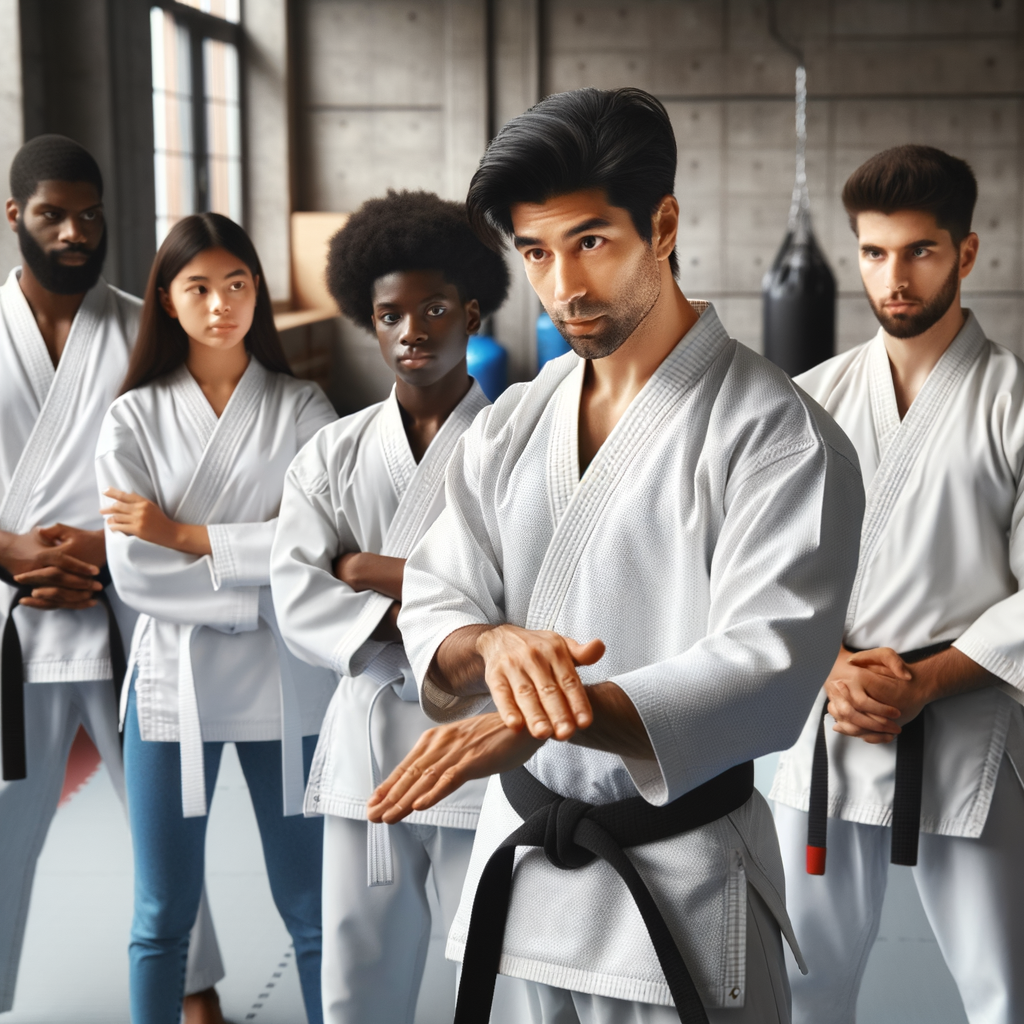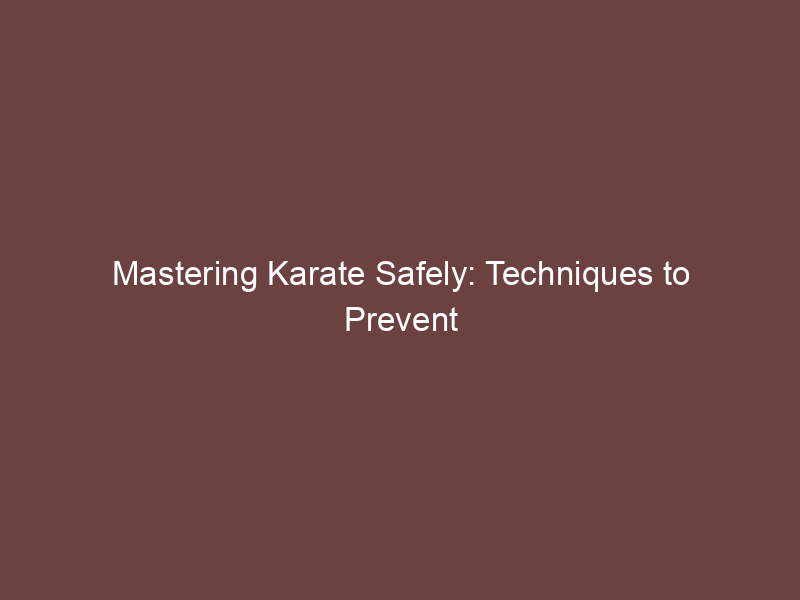
Introduction to Karate Safety Techniques
When it comes to karate, safety is paramount. Karate is a martial art that requires discipline, focus, and above all, respect for safety measures. This introduction will help you understand the importance of safety in karate and provide an overview of common injuries that can occur if safety is not prioritized.
- Understanding the importance of safety in karate
- Overview of common injuries in karate
Safety in karate is not just about preventing injuries. It’s about creating an environment where everyone can learn and grow without fear of harm. Karate is a discipline that teaches respect for oneself and others. This respect extends to the safety of all participants. Ignoring safety measures can lead to unnecessary injuries and disrupt the learning process.
Moreover, understanding and practicing safety techniques in karate also helps to build self-confidence. It allows students to push their boundaries while knowing they are in a safe environment. This can lead to improved performance and a more enjoyable experience overall.
Despite the emphasis on safety, injuries can still occur in karate. Some of the most common injuries include sprains and strains, especially in the ankles and wrists. These are often the result of improper technique or lack of warming up.
Other common injuries include bruises and cuts, which can occur from accidental contact during sparring. More serious injuries can include fractures and concussions, but these are less common and are usually the result of not following safety guidelines.
Understanding these common injuries can help you take steps to prevent them. This includes proper warm-up and cool-down routines, using correct technique, and wearing appropriate protective gear.
Remember, safety in karate is everyone’s responsibility. By understanding the importance of safety and being aware of common injuries, you can help create a safer environment for everyone involved.
Injury Prevention in Karate
In the world of martial arts, karate is a popular choice for many. However, like any physical activity, it comes with the risk of injuries. But don’t worry! With the right approach, you can significantly reduce these risks and enjoy your karate journey safely. Let’s dive into some essential aspects of safe training in karate.
Safe Training in Karate
Safe training in karate involves three key elements: proper warm-up exercises, correct technique execution, and the importance of rest and recovery. Let’s explore each of these in detail.
- Proper Warm-Up Exercises
- Correct Technique Execution
- Importance of Rest and Recovery
Warming up before any physical activity is crucial, and karate is no exception. A good warm-up increases your body temperature, improves flexibility, and prepares your muscles for the workout ahead. This can significantly reduce the risk of injuries. Some effective warm-up exercises for karate include jogging, jumping jacks, and dynamic stretching.
Executing karate techniques correctly is not just about looking good – it’s about safety. Incorrect technique can lead to injuries, especially when high kicks and powerful punches are involved. Always ensure you’re performing each move as taught by your instructor, and don’t hesitate to ask for help if you’re unsure.
Rest and recovery are often overlooked, but they’re just as important as the training itself. Overtraining can lead to fatigue, decreased performance, and increased injury risk. Make sure to take adequate rest between training sessions, and listen to your body when it needs a break. Remember, karate is a marathon, not a sprint.
In conclusion, injury prevention in karate is all about training smart. By incorporating proper warm-up exercises, executing techniques correctly, and giving your body the rest it needs, you can enjoy your karate journey safely and effectively.
Karate Training Safety Tips
When it comes to karate, safety is paramount. Here are some essential tips to ensure your training is as safe as possible:
-
Wearing Appropriate Gear
One of the first steps towards safe karate training is wearing the right gear. This includes a karate uniform, also known as a ‘gi’, and protective equipment like gloves, mouthguards, and shin guards. These items protect your body from injury during training and sparring sessions. Remember, the right gear is not just about protection, it also allows you to move freely and perform techniques correctly.
-
Training Under Supervision
Training under the watchful eye of a qualified instructor is crucial. They can guide you on the correct techniques, help you avoid harmful practices, and provide immediate assistance if an injury occurs. Never attempt advanced moves without proper supervision, as this can lead to serious injuries.
-
Listening to Your Body’s Signals
Your body is your best guide. If you feel pain, fatigue, or discomfort during training, it’s a signal that something might be wrong. Don’t ignore these signs. Rest, hydrate, and seek medical attention if necessary. Overtraining can lead to injuries, so it’s important to balance your training with adequate rest and recovery.
By following these safety tips, you can enjoy karate training while minimizing the risk of injuries. Remember, karate is not just about physical strength, but also about discipline, respect, and care for oneself and others.
Preventing Injuries in Karate
When it comes to karate, safety is paramount. Injuries can not only hinder your progress but also cause long-term health issues. Here are some techniques you can adopt to prevent injuries during your karate training.
Techniques for Safe Karate Training
Safe karate training involves a combination of physical preparation and regular health maintenance. Here are three key areas to focus on:
- Proper stretching and flexibility exercises
- Strength and conditioning
- Regular health check-ups
Stretching is crucial before any physical activity, especially karate. It helps prepare your muscles for the intense movements and reduces the risk of injuries. Flexibility exercises, on the other hand, improve your range of motion, allowing you to perform karate moves more efficiently and safely.
Strength and conditioning exercises help build muscle endurance and power, which are essential for executing karate techniques. They also enhance your overall fitness level, reducing the likelihood of getting injured.
Regular health check-ups are vital to ensure your body is in the best condition for karate training. These check-ups can help detect any potential health issues early and prevent them from escalating into serious problems.
Remember, safety should always be your top priority in karate. By incorporating these techniques into your training routine, you can significantly reduce your risk of injury and enjoy a safer and more productive karate journey.
Karate Injury Prevention Methods
While practicing karate, it’s important to take steps to prevent injuries. Here are a few methods that can help keep you safe and healthy:
- Hydration and nutrition
- Proper breathing techniques
- Mental preparation and focus
Staying hydrated and eating a balanced diet are critical for preventing injuries in karate. Drinking plenty of water helps your body function properly and keeps your muscles flexible. Eating a balanced diet provides your body with the nutrients it needs to repair and build muscles. For example, proteins help repair muscle tissue, while carbohydrates provide energy for your workouts.
Proper breathing techniques can also help prevent injuries. When you breathe correctly, you supply your muscles with the oxygen they need to function properly. Moreover, proper breathing can help you stay calm and focused, reducing the risk of making mistakes that could lead to injuries. A common breathing technique in karate is to inhale slowly through the nose, hold the breath for a moment, and then exhale slowly through the mouth.
Mental preparation and focus are just as important as physical preparation in preventing injuries. By staying focused, you can better anticipate your opponent’s moves and react quickly to avoid injury. Mental preparation, such as visualization and meditation, can also help you stay calm and focused during your training.
In conclusion, preventing injuries in karate involves a combination of physical and mental preparation. By staying hydrated, eating a balanced diet, practicing proper breathing techniques, and maintaining mental focus, you can significantly reduce your risk of injury and enjoy your karate training safely.
Safety Measures in Karate Training
When it comes to karate, safety is paramount. It’s not just about the kicks and punches, but also about preventing injuries. Let’s delve into some key aspects of injury prevention in karate.
Karate and Injury Prevention
There are three main elements that contribute to injury prevention in karate: discipline and respect, the role of a good instructor, and understanding your body’s limits.
- Importance of Discipline and Respect
- Role of a Good Instructor
- Understanding Your Body’s Limits
Discipline and respect are fundamental in karate. They are not just about showing respect to your instructor and peers, but also about respecting the art of karate itself. This includes following the rules, practicing regularly, and not using your skills inappropriately. A disciplined and respectful karateka is less likely to get injured as they are mindful of their actions and those of others.
A good instructor plays a crucial role in preventing injuries. They not only teach the correct techniques but also ensure that students are performing them safely. They correct improper forms that could lead to injuries and encourage safe practices. A good instructor is also observant, able to identify when a student is pushing too hard or when they are not ready for a more advanced move.
Every person’s body is different, and understanding your body’s limits is essential to prevent injuries. It’s important to listen to your body and not push it beyond its capabilities. If a move feels uncomfortable or painful, it’s a sign that you’re pushing too hard. Remember, karate is a journey, not a race. Progressing at your own pace will not only prevent injuries but also make your karate journey more enjoyable.
By adhering to these principles, you can significantly reduce the risk of injuries in karate. Remember, safety should always be your top priority.
Safe Karate Practice Techniques
Practicing karate safely is crucial to prevent injuries and ensure a long and healthy journey in this martial art. Here are some key techniques to consider:
- Importance of a Safe Training Environment
- Role of Regular Practice in Injury Prevention
- Case Study: Successful Injury Prevention in a Karate Dojo
Having a safe training environment is the foundation of any karate practice. This includes a clean and spacious dojo, or training area, with enough room for movement. The floor should be soft enough to cushion falls, but firm enough to provide stability. Equipment such as punching bags and training dummies should be in good condition. Safety measures like first aid kits should be readily available.
Regular practice plays a significant role in preventing injuries. It helps to build strength, flexibility, and coordination, which are all essential for safe karate practice. Regular training also helps to improve technique, reducing the risk of injury from incorrect movements. It’s important to remember that practice should be consistent, but not excessive, as overtraining can lead to injuries as well.
Let’s look at a case study of a karate dojo that has successfully implemented these safety measures. The dojo, located in Tokyo, Japan, has had zero serious injuries in the past five years. They attribute their success to their emphasis on a safe training environment and regular practice. The dojo is well-maintained and spacious, with high-quality equipment. Students are encouraged to train regularly, but also to listen to their bodies and rest when needed. This case study serves as a great example of how these safety measures can lead to a successful and injury-free karate practice.
In conclusion, practicing karate safely involves a combination of a safe training environment and regular, but not excessive, practice. By implementing these measures, we can enjoy the many benefits of karate while minimizing the risk of injury.
Conclusion: Mastering Karate Safely
In this article, we have learned a lot about karate and how to practice it safely. Let’s take a moment to recap the key takeaways and discuss the importance of continuous learning and improvement in mastering karate safely.
- Recap of key takeaways:
- Importance of continuous learning and improvement:
Firstly, we have learned that safety is paramount in karate. We discussed various safety techniques, including proper warm-up and cool-down routines, correct form and technique, and the use of protective gear. We also highlighted the importance of listening to your body and not pushing beyond your limits to prevent injuries.
Secondly, we delved into injury prevention, understanding that injuries in karate are not uncommon but can be minimized with the right precautions. We learned about common karate injuries, their causes, and how to prevent them.
Lastly, we explored safety measures in karate training. We learned that a safe training environment, a knowledgeable instructor, and a respectful attitude towards others are all crucial elements of safe karate practice.
Mastering karate is not a destination, but a journey. It requires continuous learning and improvement. As we continue to practice and learn, we become better at executing techniques safely and effectively. It’s important to remember that every karateka, regardless of their level, can always learn something new.
Continuous learning also helps us to stay updated with the latest safety practices and techniques in karate. It allows us to improve our skills, increase our knowledge, and reduce the risk of injury.
Remember, the goal is not to be better than others, but to be better than we were yesterday. As the famous karate master Gichin Funakoshi once said, “Karate is like boiling water; without heat, it returns to its tepid state.” So, let’s keep learning, improving, and practicing karate safely.






